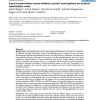35 search results - page 3 / 7 » Evolutionary models for insertions and deletions in a probab... |
BMCBI
2005
13 years 5 months ago
2005
Background: General protein evolution models help determine the baseline expectations for the evolution of sequences, and they have been extensively useful in sequence analysis an...
BMCBI
2010
13 years 5 months ago
2010
Background: While most multiple sequence alignment programs expect that all or most of their input is known to be homologous, and penalise insertions and deletions, this is not a ...
BMCBI
2005
13 years 5 months ago
2005
Background: Evolutionary distances are a critical measure in comparative genomics and molecular evolutionary biology. A simulation study was used to examine the effect of alignmen...
PSB
2004
13 years 7 months ago
2004
ct The preferential conservation of transcription factor binding sites implies that non-coding sequence data from related species will prove a powerful asset to motif discovery. We...
BMCBI
2008
13 years 5 months ago
2008
Background: Comparative genomics aims to detect signals of evolutionary conservation as an indicator of functional constraint. Surprisingly, results of the ENCODE project revealed...


